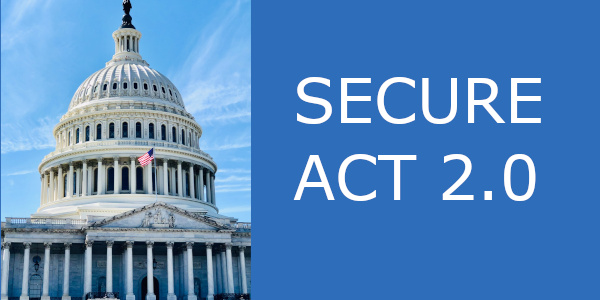SECURE Act 2.0 has set to improve on the original SECURE Act passed in July 2019. The Setting Every Community Up for Retirement Enhancement Act was designed to increase access to tax-advantaged accounts and to help simplify retirement plan rules. SECURE 2.0’s stated goal says that it is “to increase retirement savings, simplify and clarify retirement plan rules, and for other purposes.” There are a lot of big changes with this bill that will affect everyone’s retirement so it is important to understand how these changes can impact you.
What is changing with SECURE 2.0?
Required Minimum Distributions are Changing
- The current age to begin RMDs has been increased to age 73 starting in 2023 (up from age 72). RMDs will increase to age 75 starting in 2033.
- The penalty for failing to take an RMD is decreasing. The prior penalty was 50% of the RMD amount not taken. Starting in 2023, the penalty has been decreased to 25%. The penalty could be as low as 10% if the IRA owner withdraws the missed RMD and submits a corrected tax return in a timely manner.
- Starting in 2024, RMDs will not be required for Roth accounts held in employer retirement plans. This is great news to see as account owners were being unjustly penalized for staying with an old employer account.
Catch-up Contributions are Increasing (with a catch)
- Starting in 2025, if you are age 60 to 63 you can make a catch-up contribution up to $10,000 a year within a work plan (increased from $7,500). Going forward, catch-up contributions will be indexed for inflation.
- Income limitations (the catch, kind of)
- If your income is more than $145,000 in the prior calendar year, all catch-up contributions will have to be made as Roth (no tax deduction). This is still great to see as most people should be considering Roth contributions.
- Starting in 2024, the $1,000 catch-up for IRA owners will now increase every year indexed for inflation
Employers Can Match with Roth Now
- Employers will now have the option to match with Roth contributions in employer-sponsored plans. Hopefully we will see this catch on with employers in an effort to attract new hires. Previously, employers were only allowed to match with pre-tax contributions.
Automatic Enrollment
- Starting in 2025, employers adopting new 401(k) and 403(b) plans will now be required to automatically enroll eligible employees with a starting contribution rate of at least 3%
- The contributions will increase each year by 1% until contributions reach 10%
- Employees will have to opt out of this feature
Emergency Savings
- Starting in 2024, employers are now able to add an emergency savings account to help employees save. The emergency savings account would be set up as a Roth account that allows up to $2,500 in contributions a year. The account would allow 4 withdrawals a year that are tax and penalty free. These contributions may also be eligible for a company match. This will help to avoid the 10% early withdrawal penalty if funds are needed for an emergency.
Student Loan Debt
- Starting in 2024, employees that are paying back student loans may be able to receive an employer match without making a defined plan contribution. Employers will be able to “match” employee student loan payments with matching payments into an employer sponsored retirement account.
- After the employee pays off their student loan the thought is that they can now redirect that monthly payment towards their retirement plan
529 Plans
- Starting in 2024, 529 plans that aren’t used to cover qualified education expenses can now be rolled over into a Roth IRA designated to the beneficiary. This will help to avoid the funds being subject to income taxes and the 10% early distribution penalty.
- $35,000 lifetime max is eligible to be converted from a 529 plan to a Roth IRA
- There are some restrictions:
- The 529 must have the same beneficiary for at least 15 years
- The amount rolled over cannot exceed the annual IRA contribution limits
- 5-year rule: any contributions to a 529 plan within the last 5 years plus earnings cannot be converted to a Roth IRA.
Qualified Charitable Distributions (QCDs)
- Starts in 2023, investors may be eligible to elect up to $50,000 of their QCD limit into a charitable remainder unitrust, remainder annuity trust, or charitable gift annuity.
SEP and SIMPLE Now Have a Roth Option
- Starts in 2023, previously SEP and SIMPLE plans did not have a Roth option for self-employed and small business owners. SECURE 2.0 now allows a Roth option in both SEP and SIMPLE plans now.
Reach Out to Us!
If you have additional federal benefit questions, reach out to our team of CERTIFIED FINANCIAL PLANNER™ (CFP®), Chartered Federal Employee Benefits Consultants (ChFEBC℠), and Accredited Investment Fiduciaries (AIF®). At PlanWell, we focus on retirement planning for federal employees. Learn more about our process designed for the career federal employee.
Preparing for a federal retirement? Check out our scheduled federal retirement workshops. Sign up for our no-cost federal retirement webinars. Make sure to plan ahead and reserve your seat for our FERS webinar, held every three weeks. Want to have PlanWell host a federal retirement seminar for your agency? Reach out, and we’ll collaborate with HR to arrange an on-site FERS seminar.
Want to fast-track your federal retirement plan? Skip the FERS webinar and start a one-on-one conversation with a ChFEBC today. You can schedule a one-on-one meeting.










